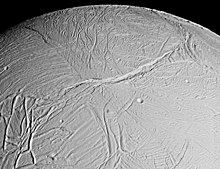Labtayt Sulci

Labtayt Sulci is a system of deep fractures on Saturn's moon Enceladus. Labtayt Sulci was first seen in low-resolution Voyager 1 images, but was observed in much more detail by the Cassini spacecraft during its February 2005 flyby of Enceladus. It is centered at 28.0° South Latitude, 284.0° West Longitude and is approximately 162 kilometers long, 4 kilometers wide, and 1 kilometer deep. The association between a cusp along the South Polar terrain boundary and Labtayt suggests that the fracture was forced open by thrust faulting where the fracture intersects with Cashmere Sulci.[1]
Labtayt Sulci is named after Labtayt, the capital of Roum in the tale "The City of Labtayt", from the book One Thousand and One Nights.
Notes and references
- ^ Porco, C. C.; Helfenstein, P.; Thomas, P. C.; Ingersoll, A. P.; Wisdom, J.; West, R.; Neukum, G.; Denk, T.; Wagner, R. (10 March 2006). "Cassini Observes the Active South Pole of Enceladus" (PDF). Science. 311 (5766): 1393–1401. Bibcode:2006Sci...311.1393P. doi:10.1126/science.1123013. PMID 16527964. S2CID 6976648.
External links
- NASA Astronomy Picture of the Day: Labtayt Sulci on Saturn's Enceladus (22 December 2008)
28°S 284°W / 28°S 284°W / -28; -284
- v
- t
- e
| Plains |
|
|---|---|
| Sulci |
|
| Fossae |
|
| Craters |
|
| Other |
|

| Past flybys | |
|---|---|
| Proposed |
|
- In mythology
- In fiction
 | This article about an extraterrestrial geological feature is a stub. You can help Wikipedia by expanding it. |
- v
- t
- e









